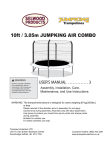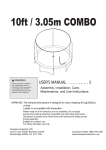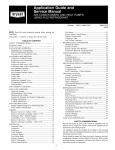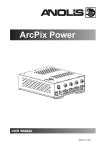Download MaxTech NXP-16 User`s guide
Transcript
High Performance Plug and Play 16-bit Ethernet Adapter NXP-16 USER'S GUIDE Part #MAN107 Rev. 1.0 NX16BT/D Contents Section One - Introduction ......................... 1 Section Two - Installation ........................... 2 Section Three - Driver Installation .............. 8 Section Four - Troubleshooting .................. 8 Section Five - Cable Information ............. 10 Section Six - Specifications ..................... 10 Section Seven - Technical Support .......... 11 Section Eight - Notices ............................. 12 Section One - Introduction Maxtech network adapters are high performance, Industry Standard Achitecture (ISA) Ethernet network adapters designed for Plug and Play (PnP) systems. The adapters are NE-2000 compatible and include a 16KB RAM buffer for improved network transmission and reception. Plug and Play is a set of specifications that define the ability for the computer hardware or operating system to automatically configure all devices that are installed, relieving the user of the need to determine which addresses and interrupts to use for each device. For non-PNP (legacy) systems, a setup program (SETUP.EXE) is provided to configure the cards for use in any IBM PC/XT/AT or fully-compatible computer. The minimum hardware requirement is an IBM PC/ XT or fully-compatible PC with 512K RAM running DOS 6.2 or higher. The network operating system you use may have higher requirements. 1 Section Two - Installation This section provides step-by-step instructions on how to install your new network adapter. Installation of this network adapter is a two-step process consisting of actual hardware installation and card configuration. This network adapter is designed to be configured by the Plug and Play capabilities of the host computer/operating system. Also, the adapter can be installed and configured in a legacy system by using the setup program (SETUP.EXE) included on the driver diskette. 2.1 Unpacking Your Network Adapter Two types of network adapter cards are available. Before you proceed, determine the model you have purchased. The following table summarizes the contents and features of your Ethernet product: Model NXP-16T x x Adapter Card RJ-45 BNC BNC T-connector Boot ROM Socket Installation disk User's Guide LINK LED* ACT LED x x x x x NXP-16BT x x x x x x x x x *Note: The LINK LED only indicates a twisted-pair connection. It is disabled for any other cable type. 2.2 Hardware Installation Installation of this adapter card requires opening and manipulating your PC. Exercise caution at all times when working with AC powered and staticsensitive equipment. Turn off and unplug your PC 2 before installation. Discharge any static electricity from your body by touching any metal surface. 1. 2. 3. 4. 5. 6. 7. 8. 9. Turn off your computer and all peripherals. Make a note of the power cord and other cables connected to your computer and disconnect them. Remove your computer’s cover (refer to your computer’s owner manual). Select any available Figure 1 expansion slot, and then remove the slot cover (refer to Figure 1). A 16-bit expansion slot is recommended. Touch the computer chassis before removing the adapter from its anti-static bag. This will discharge any static electricity from your body. Carefully install the adapter by firmly pressing the card into the slot you have chosen, applying even pressure until the adapter is completely seated in the slot. Fasten the retaining bracket with the screw from the slot cover. Make sure the adapter is properly aligned. Store the slot cover for future use. Replace the computer cover and reconnect the power cord and all cables. Attach the network cable to your adapter. 2.3 Card Configuration Plug and Play systems determine the network card's configuration during boot up. Non-PnP systems require the use of the setup program, SETUP.EXE, included on the driver diskette in the root directory to configure the card. Proceed to the section which matches your system configuration: 3 Section 2.3.1 for all Windows 95 systems Section 2.3.2 for PnP systems without Windows 95 Section 2.3.3 for Non-PnP Systems 2.3.1 Configuration in Windows 95 When Windows 95 starts for the first time after card installation, it detects the adapter as an NE2000 compatible card. If Windows displays the New Hardware Found dialog box, proceed to Section 2.3.1.1. If Windows displays the Update Device Driver Wizard, proceed to Section 2.3.1.2. 2.3.1.1 Windows 95 Release 4.00.950 Under New Hardware Found, when asked to “Select which driver you want to install for your new hardware,” click on “Driver from disk provided by hardware manufacturer.” Click “OK.” The Install From Disk dialog box now instructs you to “Insert the manufacturer's installation disk into the drive selected, and then click OK.” Insert the adapter's driver diskette and type A:\WIN95 (or B:\WIN95 if inserted in drive B) in the “Copy manufacturer's files from:” box. Click “OK.” The Select Device dialog box presents the selection for the adapter. Click “OK” to install the adapter. Windows 95 may request its own installation disks for some files. Insert the Windows 95 disks as required. When all necessary files are copied, the adapter is configured. Restart Windows 95 as prompted. 2.3.1.2 Windows 95 Release 4.00.950 B When Windows 95 starts for the first time after card installation, it detects the card and displays the Update Device Driver Wizard. Insert the driver disk into the disk drive and click “Next.” Windows will search for the driver on the driver disk. If you need to enter the location of the driver, click “Other Location,” type A:\WIN95 (or 4 B:\WIN95) in the entry box and click “OK”. Click “Finish.” Windows 95 may request its own installation disks or CD for some files. Insert the Windows 95 disks or CD as required. When all necessary files are copied, the adapter is configured. Restart Windows 95 as prompted. 2.3.2 Configuration in PnP Systems without Windows 95 If the card is installed in a PnP system without Windows 95, the system assigns the card an I/O Base Address and IRQ. Run SETUP.EXE in the root directory of the driver diskette and use the View Current Configuration option to confirm the adapter's configuration. If you wish to change the card configuration from the one assigned, select Setup, change the Operating Mode to Jumperless and configure the adapter as outlined in Section 2.3.3 for legacy systems. Continue to Section 2.4 to run adapter diagnostics to ensure correct installation. 2.3.3 Configuration in Legacy Systems When using the card on a legacy (non-PnP) system, the setup and diagnostic program SETUP.EXE is used to configure the adapter. Note: To use the network card in a legacy system, the Operating Mode must be set to Jumperless instead of Plug and Play To run the setup program, insert the driver diskette into drive A: (or B:). 1. 2. 3. 4. 5. At the DOS prompt type A:\SETUP Select Setup Change the Operating Mode to Jumperless. Configure the I/O Base Address and Interrupt to the desired settings for your system. Press Esc to update the adapter. 5 For more information on running SETUP, refer to the file README.TXT in the root directory of the driver diskette. The following configuration options are available in the SETUP Main Menu: • • • View Current Configuration Setup Run Diagnostics View Current Configuration displays the current settings of the card. The Setup option allows user selection of parameters such as Operating Mode, Medium type, FullDuplex Enable/Disable, I/O Base Address, Interrupt, and Boot ROM Address. Setup is used to configure the card in systems without Plug and Play capabilities. 2.4 Testing The Adapter Adapter diagnostics are included in the SETUP.EXE program found in the root directory of the driver diskette. Refer to the file README.TXT in the same directory for detailed information. Note: To run the diagnostics under Windows 95, click on Start/Shut down and select “Restart the computer in MS-DOS mode.” Run SETUP.EXE from the DOS prompt. Setup provides the following testing options when you select Run Diagnostics from its Main Menu. • Run EEPROM Test • Run Diagnostics on Board • Run Diagnostics on Network The EEPROM Test option performs read/write tests on the adapter's on-board EEPROM registers and reports the results. The Run Diagnostics on Board option runs several tests and the results are indicated by either PASS or FAIL counts. Make sure that the network 6 cable is attached (and properly terminated if using a BNC connection) to the adapter when using this option. If any test has a fail count, press the spacebar for help on the reason for the failure and possible solutions The following tests are performed in the Run Diagnostics on Board option: 1. 2. 3. 4. 5. Configuration Test: Checks the initial status of the Ethernet controller I/O Test: Check I/O accessibility Internal Loop back Test: Checks adapter's controller. External Loop back Test: Performs transmit/receive tests on the network link RAM Test: Checks on-board RAM The Run Diagnostics on Network option allows the user to test the network cable connection between two cards. One card is setup as a Responder and a second card is setup as an Initiator. The Initiator and Responder will exchange packets and display the number of transmit and receive packets that have passed or failed. Note: A Responder can only recognize one Initiator at a time. 2.5 Boot ROM Installation (optional) An empty ROM socket is provided on the adapter to accept an optional Remote Boot ROM (available from your dealer). The Boot ROM allows the PC to load the Operating System over the network for diskless applications. 1. 2. Insert the Boot ROM into the socket. Make sure that the notch on the ROM matches the one on the socket (refer to Figure 2). Configure the adapter using the SETUP program to enable the Boot ROM function by selecting the appropriate address from the Boot ROM Base Address option. Refer to Section 2.3 for more information on run7 ning the SETUP program. Figure 2 Align ROM and socket notches 3. Follow the Remote Boot Workstation installation procedure given in your network operating system manual (i.e. create a Boot Image on the server for Novell networks, or start remote booting services on LAN Manager networks, etc.). Section Three - Driver Installation The network operating system (i.e. Novell, Windows NT, LAN Manager, etc.) that you are using requires a driver to access the network adapter card. The network adapters are NE-2000 compatible and can use the NE-2000 driver supplied with your network operating system. Drivers for most popular network operating systems are included on the driver diskette in separate subdirectories. These drivers can be copied to your hard-drive by using the INSTALL.EXE program on the driver disk. Information on using each driver is available by running HELP.EXE from the root directory of the driver disk. Section Four - Troubleshooting This section describes some of the common problems you may encounter while using your network adapter. When troubleshooting, you should make sure that the network you are connected to is 8 functioning. If you suspect that the adapter is malfunctioning, replace it with another adapter which is known to function properly. Also try the adapter in another computer. This can determine whether the adapter or computer causes the problem. If you cannot resolve your difficulty after reading the following information, contact your dealer or vendor for assistance. Most adapter failure after installation is caused by A) I/O base address and IRQ Line conflict, or B) Cable problems. 4.1 I/O Base Address and IRQ Conflict Make sure that the I/O address and IRQ used by the adapter is not already in use by another device in your PC. If your PC has built-in serial ports then you will not be able to use IRQ 4 (COM1) or IRQ 3 (COM2). Other adapters in your system may already use addresses 0300H or 0320H (example: sound/audio card). Vary the settings on your network adapter by running SETUP again to eliminate the conflict. Running the diagnostics in SETUP will also help to detect configuration conflicts. 4.2 Cable Problems A) Observe the green Link Status LED if you are using a 10Base-T network. Turn on the computer. Connect the network cable and observe the green LINK LED. If the LED is ON, then the system is connected. Otherwise check for a proper RJ-45 connection. B) Make sure the coaxial cable is properly terminated if you are using a 10Base-2 network. Each end of a coaxial segment must be properly terminated with a 50-ohm terminator. You may use a simple ohm meter to determine if the cable is functioning properly. Disconnect all nodes on the network and measure the resistance of the termi9 nators. If the terminators do not measure 50 ohms +/- 1%, replace the terminator. Measure the coaxial cable with a 50-ohm terminator attached to one end. The total resistance of the cable plus the terminator should be no more than a few ohms more than the terminator alone. Section Five - Cable Information The network adapters support both popular cable schemes used in Ethernet networks: 10Base-T and 10Base-2. The following are the recommended specifications for proper network cabling. 10Base-T networks use unshielded twisted-pair cable and 8-pin RJ-45 modular connectors. Use only 22-26 AWG 2- or 4-pair 100 ohm/ft UTP (Catagory 3) or better cable. The cable must use solid copper conductors and UL codes CM, CMR, and CMP are required. The computer on the network is connected via a star topology (i.e. each node is connected to a HUB, not to each other). Maximum cable length is 300' (100 m). 10Base-2 networks use a single conductor coaxial cable and BNC connectors. Use only RG-58A/U or RG-58C/U coaxial cables. Each network node is connected to the coaxial cable via a T-connector (included). The minimum distance between Tconnectors is 1.6' (0.5m). The T-connector must be plugged directly into the network adapter (no cable is allowed between the T-connector and the adapter). No more than 30 connections are allowed per segment and the maximum segment length is 607' (185 m). The cable must be terminated at each end by one 50-ohm terminator. Section Six - Specifications Network Standard: IEEE 802.3 Computer Interface: ISA bus 8 or 16 bit, auto detect Hardware Compability: NE2000 10 I/O address: 200, 220, 240, 260, 280, 2A0, 2C0, 2E0, 300, 320, 340, 360, 380, 3A0, 3C0, 3E0 IRQ line: 2 (9), 3, 4, 5, 10, 11, 12, 15 RAM buffer: 16 KB Boot ROM address: C000, C400, C800, CC00, D000, D400, D800, DC00 Power Consumption: 2.5 W Temperature: 0 to 55 degrees C (Operating) Humidity: 10% to 90% (Non condensing) Dimensions: 6.39" x 2.48" Certification: FCC Part 15 Class B Drivers: Novell NetWare 3.x, 4.x, NetWare LAN WorkPlace TCP/IP, Novell LAN Analyzer for NetWare, Novell Personal Netware, Wollongong Pathway Access, FTP PC/TCP, NCSA TCP/IP, Microsoft LAN Manager, Microsoft Windows For Workgroups, Microsoft Windows NT, Microsoft Windows 95, IBM LAN Server, IBM LAN Support, IBM OS/2 EE V2.0, DEC Pathworks, SUN PCNFS, Banyan VINES, IBM TCP/IP for DOS and OS/2, SCO Unix. Section Seven - Technical Support In the unlikely event you experience difficulty in the use of the product, or if it does not operate as described, we suggest you: (1) consult the Troubleshooting section of this guide and (2) consult with your dealer. If you have not referred to the Troubleshooting section, there is a good chance the solution to your problem is there. If you still can not solve the problem, call the MaxTech Service Center at (562) 921-4438 between 9:00 a.m. and 6:00 p.m. (PST Monday through Friday). If the nature of your question is related to the network operating system that you are using, refer to its manual. Calling the Service Center without complete and accurate information concerning the NATURE OF THE PROBLEM will be both timeconsuming and frustrating for you. You may also reach us through: 24 hour BBS - (562) 921-7180 24 hour Faxback - (562) 921-9540 Compuserve ID - 71333,44 America Online - Keyword: Maxtech Prodigy - Jump: Manufacturers BB 11 World Wide Web - www.maxcorp.com Email - [email protected] FTP - ftp.maxcorp.com Section Eight - Notices 8.1 Five Year Limited Warranty MaxTech warrants to the original buyer of this product against defects in material and workmanship for five years from the date of purchase. During the warranty period, MaxTech will repair (or at its option, replace) the product that proves to be defective, provided the product has not been abused, misused, modified, or repaired by an unauthorized center. In the event the product requires service, follow the procedure outlined in Section Eight - Technical Support. When you are instructed by the Technical Support Representative to return the product to MaxTech for repair, you will be given an RMA (Return Merchandise Authorization) number. You must have an RMA Number to return the product for service. Use the following procedure to return the product to MaxTech: 1. 2. 4. 5. Return the product in its original package and packing (if possible), and put it in a sturdy corrugated box. Be sure to include your name, address, day-time telephone number, RMA number, and a brief description of the problem (also enclose a check for out-of-warranty repair). Enclose your check or Postal Money Order for $7.50 to cover the cost of return shipping/handling. Please do not send cash or stamps. After wrapping the package securely for shipping, print your name, return address and the RMA # clearly on the outside of your package. Ship the unit prepaid via UPS or the U.S. Postal Service To the address provided by the technician when you call. We recommend that the unit be insured. This warranty is valid for products sold in North America only. Contact your local authorized distributor or dealer for the warranty offered in other areas. All warranty services must be performed by Authorized Service Centers. There are no user serviceable parts inside the unit. Do not remove any components or attempt to service 12 the unit by any unauthorized service center. This warranty is voided if the product has been abused, misused, modified, or repaired by an unauthorized service center. 8.2 FCC Class B Statement This equipment has been tested and found to comply with the limits for a Class B digital device, pursuant to Part 15 of the FCC Rules. These limits are designed to provide reasonable protection against harmful interference in a residential installation. This equipment generates, uses and can radiate radio frequency energy, and if not installed and used in accordance with the instructions, may cause harmful interference to radio communications. However, there is no guarantee that interference will not occur in a particular installation. If this equipment does cause harmful interference to radio or television reception, which can be determined by turning the equipment off and on, the user is encouraged to try to correct the interference by one or more of the following measures: • Reorient or relocate the receiving antenna • Increase the separation between the equipment and the receiver • Connect the equipment into an outlet on a circuit different from that to which the receiver is connected • Consult the dealer or an experienced radio / TV technician for help Notice: 1) Shielded cables, if any, must be used in order to comply with the emission limits. 2) Any change or modification not expressly approved by the Grantee of the equipment authorization could void the user’s authority to operate the equipment. 8.3 Disclaimer, Copyright, And Other Notices The information contained in this manual has been validated at the time of this manual's production. The manufacturer reserves the right to make any changes and improvements in the product described in this manual at any time and without notice. Consequently the manufacturer assumes no liability for damages incurred directly or indirectly from errors, omissions or discrepancies between the product and the manual. All registered trademarks are the property of their respective owners. Copyright © 1997 All rights reserved. No reproduction of this 13 document in any form is allowed without written permission from the manufacturer. First Edition GZ/DR - Version 1.0 14 15



























